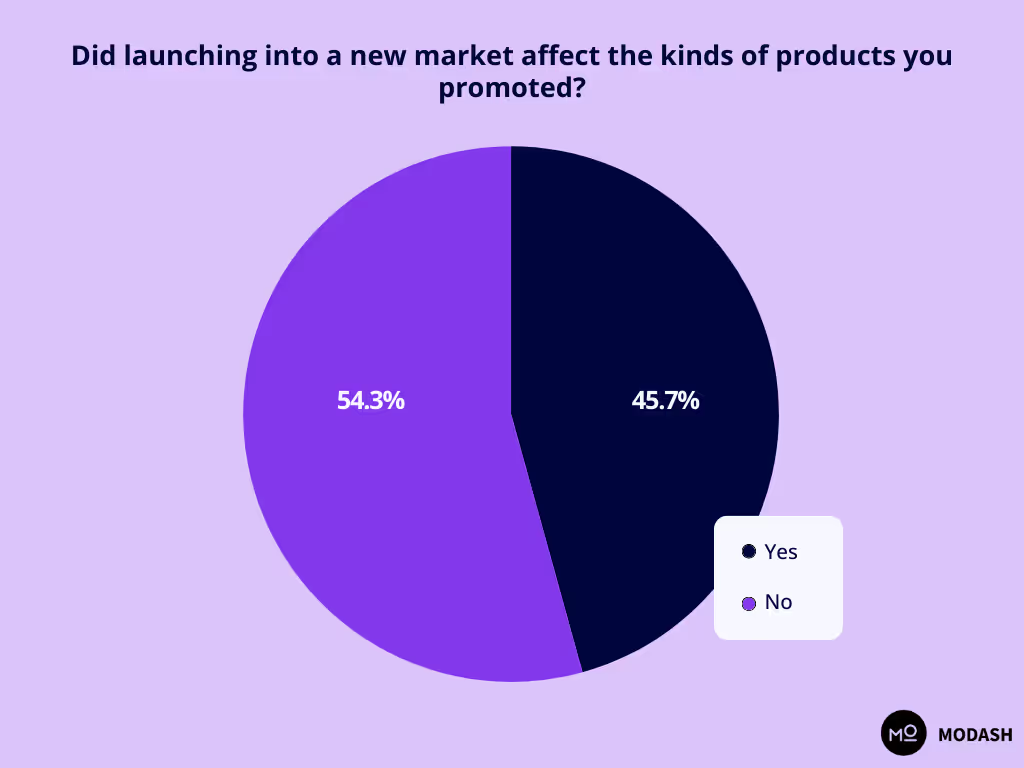Expanding into a new market sounds exciting – until you realize nothing works as it does on your home turf. And the worst part? You don’t know what you don’t know.
We asked 35 seasoned influencer marketers what they wish they knew before launching in a new market. Here are their seven hard-won lessons to take with you.
1: The most effective platforms and formats will change across markets
New market, new platforms. The most effective social media channels in one market might be totally different in another because audience preferences change with age, location, gender, and other demographics. For Leslie Belen, this was the biggest surprise when expanding to a new market:
Athira Aravind had a similar experience when YouTube worked better than Instagram for her company in a new market:
Check for statistical reports on which social media platforms your new target audience uses most – especially which ones they use to discover new brands and products.
Sometimes, a new platform simply performs better because it suits a particular content style for a new market. For example, if the new audience responds best to short-form video, you might try reaching them on TikTok instead of YouTube. Fernanda Marques explains using her experience:
She also mentioned moving her focus to TikTok, which was an overall better fit for the "fun, snackable nature of both the product and viral potential."
Many marketers in our survey had similar experiences:
- Valerija Somi found that heavily promotional content worked better than their usual subtle approach.
- Noor Ahmed found that UGC-style content was better received than sleek ads or vlogs.
- Alex Sabucido found that low/mid-production videos outperformed polished ones.
Before deciding your influencer marketing strategy for a new market, thoroughly research the preferences of your target audience in terms of social media platforms and content formats.
- What makes them convert from scrollers to buyers?
- Do they respond to overly promotional content, or do they prefer less direct marketing?
- Are they likely to make impulse purchases, or do they take their time evaluating a product before buying?
Researching these in detail will help you determine which channel and content type fits your new market best, saving you trial and error.
2: Consumer product preferences won’t be the same everywhere
Over 45% of marketers in our survey said they adapted their product catalog depending on the market.

Here’s why you might have to adapt your product catalog, too:
- You might have some competition in the local market from popular, trusted brand names.
- Your new market might have legal requirements that prohibit the sale of certain products.
- Your new market might have different buying power and cultural values that make some products less appealing than others.
Valerija speaks to some of these factors to explain why she changed the kinds of products she promoted for her new market:
Your bestselling product at home could flop in a new market… and your least popular product could sell like hotcakes. Michael Todner experienced this firsthand:
There’s a reason why McD burgers taste different around the world: each market has its own tastes. While preparing for a market expansion, pay close attention to:
- What locals value, prefer, and look for before buying products like yours
- Legal requirements in your product category
- Buying power of your new target consumers
- Existing competitors
Once you launch, test the promotion of different products in your catalog, and gather consumer and influencer feedback to determine which items are getting the most love.
3: Content that flops at home might soar in a new market
As with platform and product preferences, content choices might also differ in a new market. And this lesson is probably the hardest pill to swallow.
For example, in Japan, creators make entire long-form YouTube videos without showing their face. But in the West, the face-to-camera style is a basic requirement for developing a connection with your audience.
If you’re expanding to a vastly different market, it might be tough to accept that what works well at home is unusual in the new location. Abdullah Khan shared an example around marketing in Japan – where humor and memes didn't land in the same way. He mentioned that meme marketing worked well with younger audiences in western markets, it just didn't have the same impact as in Japan, for example.
He highlights that with different cultures come different challenges around humor, which can be very specific per market:
The solution is to offer creative freedom to your influencer partners, who know their audience (and your new market) better than you. That’s what Abdullah did, too:
Different audiences connect and respond to different kinds of content, and it’s not always immediately obvious why – especially when you’re on the outside looking in. Lee Drysdale says it best:
“Content needs to be tailored, not just translated” – make that your mantra!
4: Influencer expectations and work styles can be wildly different
Creators in different locations and segments have different work styles. In some places, deadlines are law. In other locations, they are mere suggestions. Nacho Selma shares their experience:
It’s not a question of what’s right or wrong, good or bad – after all, you can’t dictate someone’s working style. The goal is to be transparent and upfront with your new influencer partners to prevent communication bottlenecks.
You also must be flexible with your “brand fit” parameters when evaluating influencers. Yes, some non-negotiables will remain – like the creator having to align with your brand values and meet KPIs.
But beyond that, be open-minded. Sometimes, you might have to venture outside your niche to find the right creators. Other times, you might think a creator’s content is not up to scratch, but it works effectively for your new target market. Abdullah shares his experience:
Before launching in a new market, research influencer rates, workflows, communication preferences, and expectations. If you have local support, lay out your usual processes and expectations, and ask them to point out where you might encounter roadblocks.
If you don’t have local support, ask your influencers (in the new market) what process they usually follow when working with brands. You don’t have to overhaul your systems, but meet your creator partners somewhere in the middle.
Remember to be patient; it might take a few collaborations to understand each other’s expectations and working style. Instead of trying to forge ahead with the systems from your home market, show your new creator partners that you’re willing to adapt to them – you’ll lay the right foundation for your influencer relationships.
5: Campaign timelines tend to stretch longer than expected
New markets come with new timelines. Product shipping might get delayed, influencers might need more time to create content, the approval process might take longer… I could go on. For Noor, the market research process took longer than anticipated. For Greta Zacchetti, testing new influencer clusters and identifying which would perform best took more time:
When you’re in the planning and strategizing stage, it’s hard to predict what could go sideways. But you’re still answerable to stakeholders if your internal deadlines get pushed, even if it’s due to factors outside your control. Tamara Torrecillas suggests staying agile by including a buffer in your timelines:
Pad each deadline in your campaign timeline to ensure you don’t have to rush, and don’t be afraid to ask for more time than you think you need in the preparation phrase.
Forty percent of marketers in our survey said they planned for a new market launch for 1–3 months, 20% said they took 3–6 months, and another 20% said they started preparing 6–9 months in advance.

It’s not wrong to hope that everything goes as planned and that all deadlines are met on schedule, but it’s wise to prepare for the unexpected, including for hiccups outside of your control.
6: Niche creators can outperform big-name influencers
On the surface, it seems more valuable to partner with a celebrity than a small influencer. The bigger the influencer, the more awareness you gain in a new market, right?
But big influencers also come with high stakes. Greta explains how your reputation might be at risk if you don’t choose a new-market celebrity carefully:
Additionally, in some markets, large influencers don’t have a tightly-knit local audience – instead, they have a diversified, international one. Flora Macher elaborates:
In this case, a smaller influencer would make for a better partner in a new market because not only are they low-risk, but they’ll also likely have an engaged community of your target audience. For Senith Berhane, choosing smaller creators who have their audience’s trust over a big-name celebrity was game-changing:
By all means, if you can afford big influencers and are sure they will deliver, definitely partner with them to make a big splash in a new market. But mix it up with partnerships from small, niche creators, too – this will help spread your bets and balance the scales. If your budget allows only for one big influencer or 3–6 smaller influencers, go with the latter to reduce your risk.
What matters more than size, though, is the quality of the influencer you’re partnering with – so be sure to vet their profile thoroughly. Using Modash, you can evaluate their audience demographics, engagement rate, follower growth, and much more.

Vetting with Modash first will give you the confidence that you’re matching with the right creators in your new market from the get-go.
7: Local agencies can give you an edge from day one
Partnering with a local agency (or even a local freelancer) is like taking the shortcut to success in a new market. They can help you:
- Navigate any cultural gulfs, expectations, and translations
- Help you find the right local influencers and build trust with them
- Act as your sounding board for any questions or ideas you have, or any hiccups you encounter
Julianne Kiider adds that collaborating with someone local can even speed up the campaign process:
You might not need agency support if you’re expanding to a new segment or a familiar market, but if you’re expanding internationally where the culture, language, and expectations are wildly different from what you’re used to, hiring local support will set you up for success from day one.
Remember to vet the agency or freelancer first. Ask for referrals, get on a call, and do the legwork before committing to a local partner. Victor Wiśniowski explains why this is crucial:
Now you know
Launching in a new market rarely means copying and pasting your strategies from one area/segment to another. It involves being flexible and expecting the unexpected.
But now that you know what other seasoned pros wish they knew, you’re already ahead of the game.
Here’s another thing that will set you apart: Modash. It gives you the data and the tools you need to find, manage, and collaborate with creators – no matter where they’re from. It adapts to every market (just like you 😉). Give it a go at no cost for two whole weeks.





















